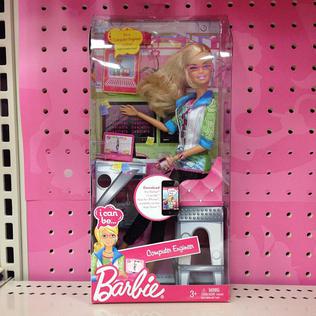
Mattel, Inc. is an American multinational toy manufacturing and entertainment company founded in Los Angeles by Harold Matson and the husband-and-wife duo of Ruth and Elliot Handler in January 1945 and headquartered in El Segundo, California. Mattel has a presence in 35 countries and territories; its products are sold in more than 150 countries. Mattel consists of three business segments: North America, International and American Girl.

Barbie is a fashion doll created by American businesswoman Ruth Handler, manufactured by American toy and entertainment company Mattel and introduced on March 9, 1959. The toy was based on the German Bild Lilli doll which Handler had purchased while in Europe. The figurehead of an eponymous brand that includes a range of fashion dolls and accessories, Barbie has been an important part of the toy fashion doll market for over six decades. Mattel has sold over a billion Barbie dolls, making it the company's largest and most profitable line. The brand has expanded into a multimedia franchise since 1984, including video games, animated films, television/web series, and a live-action film.

Kenneth Sean "Ken" Carson Jr. is a fashion doll introduced by American toy company Mattel in 1961 as the counterpart of Barbie, who had been introduced two years earlier.
Gender neutrality, also known as gender-neutralism or the gender neutrality movement, is the idea that policies, language, and other social institutions should avoid distinguishing roles according to people's sex or gender. This is in order to avoid discrimination arising from the impression that there are social roles for which one gender is more suited than another. The disparity in gender equality throughout history has had a significant impact on many aspects of society, including marketing, toys, education and parenting techniques. In order to increase gender neutrality in recent years, there has been a societal emphasis on utilizing inclusive language and advocating for equality.
Polly Pocket is a toy line of dolls and accessories first founded and designed by Chris Wiggs in 1983 and licensed by Bluebird Toys from 1989 until both entities/properties were acquired by Mattel in 1998.
Chatty Cathy was a pull-string "talking" doll originally created by Ruth and Elliot Handler and manufactured by the Mattel toy company from 1959 to 1965. The doll was first released in stores and appeared in television commercials beginning in 1960, with a suggested retail price of $18.00, though usually priced under $10.00 in catalog advertisements. Chatty Cathy was on the market for six years and was the second most popular doll of the 1960s after Barbie.

Fashion dolls are dolls primarily designed to be dressed to reflect fashion trends. They are manufactured both as toys for children to play with and as collectibles for adults. The dolls are usually modeled after teen girls or adult women, though child, male, and even some non-human variants exist. Contemporary fashion dolls are typically made of vinyl or another plastic.

What's Her Face! was a line of customizable dolls that straddled the line between traditional fashion dolls and creative activity toys. Made by Mattel, the line ran from 2001–2003, and enjoyed only a modest success in a market dominated by Mattel's iconic Barbie and MGA Entertainment's Bratz dolls. Following the discontinuation of the What's Her Face! line, their body molds were used for the Wee 3 Friends line of Barbie-related dolls. Several fashion, wig, and activity packs were also released for the What's Her Face line.
The gender binary is the classification of gender into two distinct forms of masculine and feminine, whether by social system, cultural belief, or both simultaneously. Most cultures use a gender binary, having two genders.

Sindy is a British fashion doll created by Pedigree Dolls & Toys in 1963. A rival to Barbie, Sindy's look and range of fashions and accessories made her the best-selling toy in the United Kingdom in 1968 and 1970. After Marx Toys' unsuccessful attempt to introduce Sindy in the United States in the late 1970s, Hasbro bought the rights to Sindy and remodelled the doll to look more American. As a result, the doll's popularity declined; in addition, Barbie manufacturer Mattel filed a lawsuit for copyright infringement, which was settled when Hasbro agreed to remodel Sindy's face. During the 1990s, Barbie's share of the doll market continued to grow while Sindy's diminished, which led to Sindy being delisted from major retailers in 1997. Hasbro returned the doll's licence to Pedigree, and the doll was relaunched in 1999, manufactured by Vivid Imaginations. Sindy's 40th anniversary in 2003 saw a new manufacturer, New Moons, and another relaunch and redesign. There were further relaunches in 2016 by Tesco and in 2021 by Kid Kreations.
Barbie and the Rockers was a doll line created in the mid-1980s by Mattel to compete with Hasbro's popular Jem doll line. They were on the market for roughly 3 years; a direct-to-video special, titled Barbie and the Rockers: Out of This World, was released in 1987. The characters include Diva, Dana, Dee-Dee, and Derek; Ken joined the band in later waves.
Toy advertising is the promotion of toys through a variety of media. Advertising campaigns for toys have been criticized for trading on children's naivete and for turning children into premature consumers. Advertising to children is usually regulated to ensure that it meets defined standards of honesty and decency. These rules vary from country to country, with some going as far as banning all advertisements that are directed at children.
Earring Magic Ken, also known as "Gay Ken" and "Fey Ken", is a model of the Ken doll introduced by Mattel in 1993 as a companion to its Earring Magic Barbie figure, one of five dolls in the Earring Magic Barbie line.
Elliot Handler was an American inventor, businessman, and the co-founder of Mattel. With his wife, Ruth Handler, he developed some of the biggest-selling toys in American history, including Barbie, Chatty Cathy, Creepy Crawlers, and Hot Wheels.
Monster High is an American multimedia-supported fashion doll franchise created by toy designer Garrett Sander and launched by Mattel in 2010. The show is aimed at children ages 7-14, the franchise features characters inspired by monster movies, sci-fi horror, thriller fiction, folklore, myths and popular culture, centering around the adventures of the teenage children of monsters and other mythical creatures attending a high school of the same name.

Girls' toys and games are toys and games specifically targeted at girls by the toy industry. They may be traditionally associated either exclusively or primarily with girls by adults and used by girls as an expression of identity. One commentator have argued that the market for girl's toys and games is more challenging than that for boys' toys and games.

Lammily is an American fashion doll developed by Nickolay Lamm in 2014. The doll was conceived as an "average" alternative to Mattel's Barbie line, which has received controversy over its body image and proportions. Lamm created the toy using proportions of the average 19-year-old woman as indicated by the Centers for Disease Control (CDC) (Petri). The name "Lammily" was formed by combining his last name and "family".

Computer Engineer Barbie is the 126th career version of Mattel's Barbie doll. In response to poll results indicating strong support for computer engineers, the doll set was created and introduced in 2010. In 2014, Mattel apologized for the accompanying book, I Can Be a Computer Engineer, after complaints that it represented Barbie as incompetent in the field, needing the help of men.

Queer fashion is fashion among queer and nonbinary people that goes beyond common style conventions that usually associate certain colors and shapes with one of the two binary genders. Queer fashion aims to be perceived by consumers as a fashion style that focuses on experimenting garments based on people's different body shapes instead of following the restrictions given by gendered clothing categorization.












